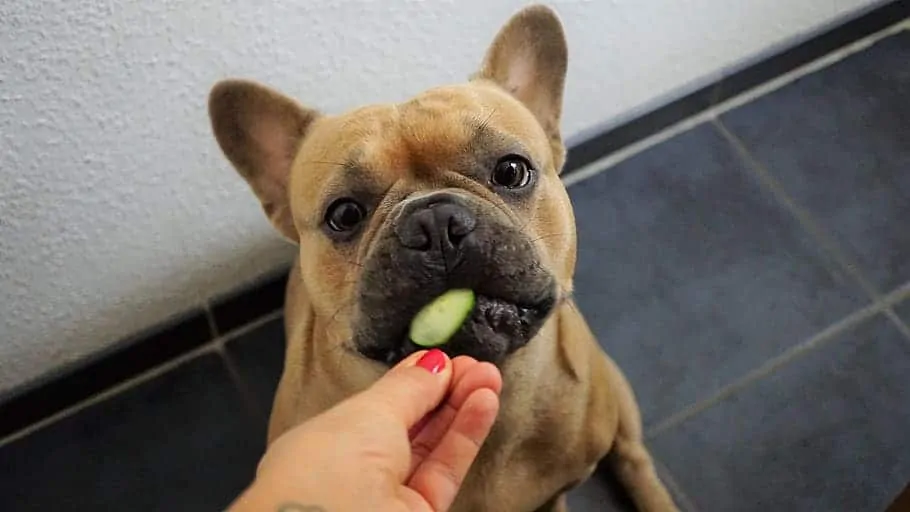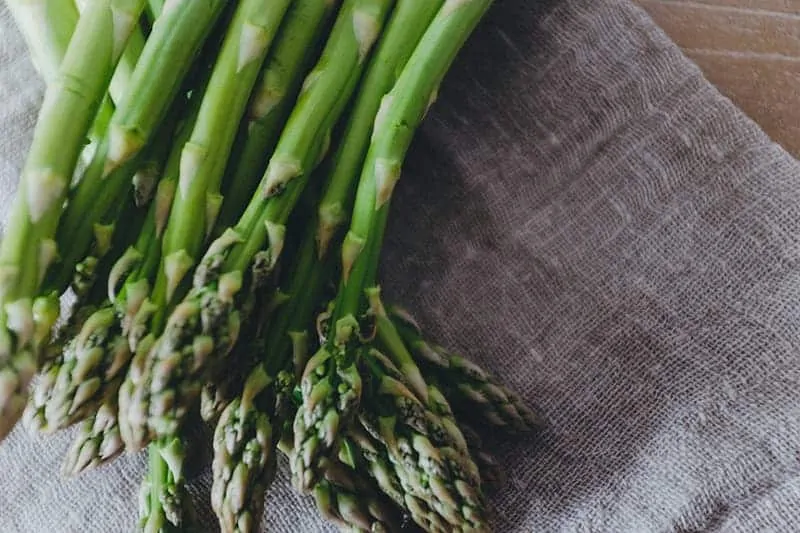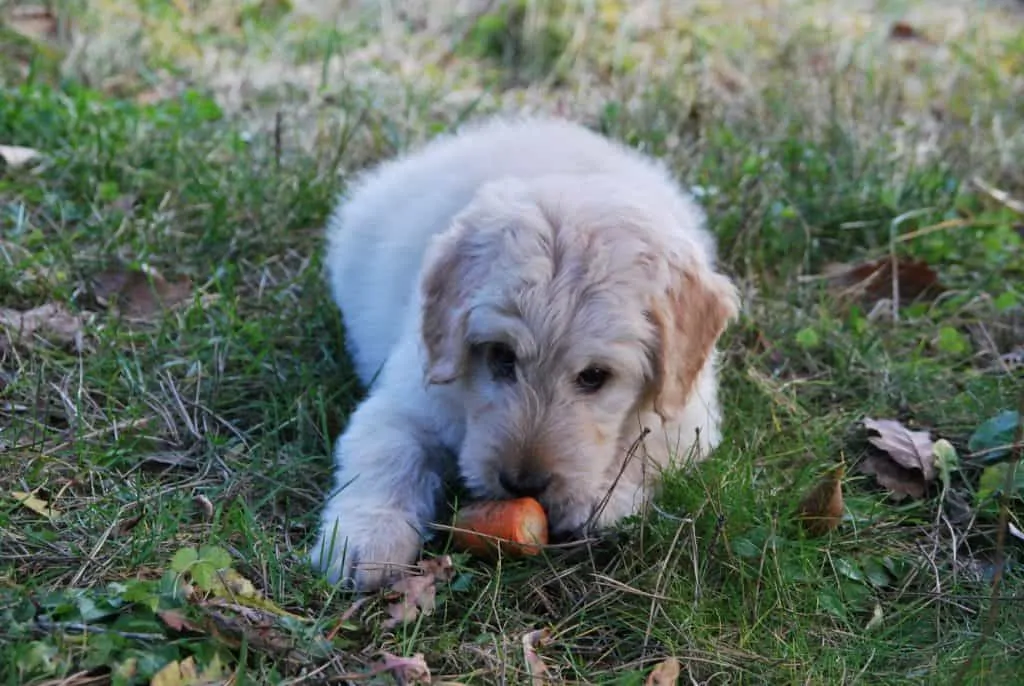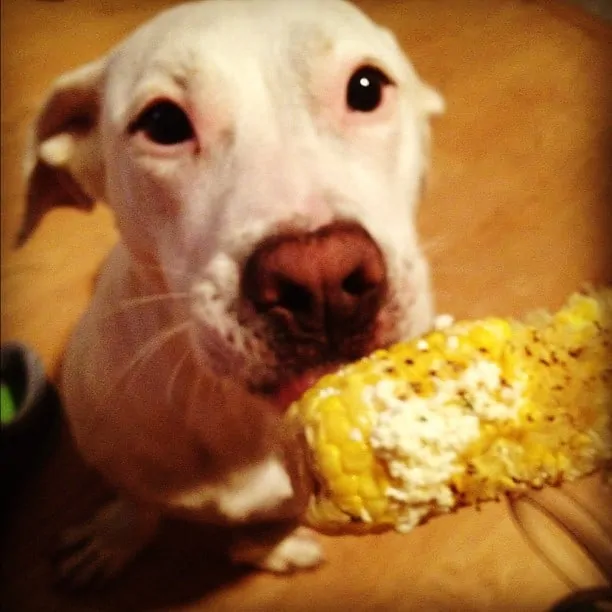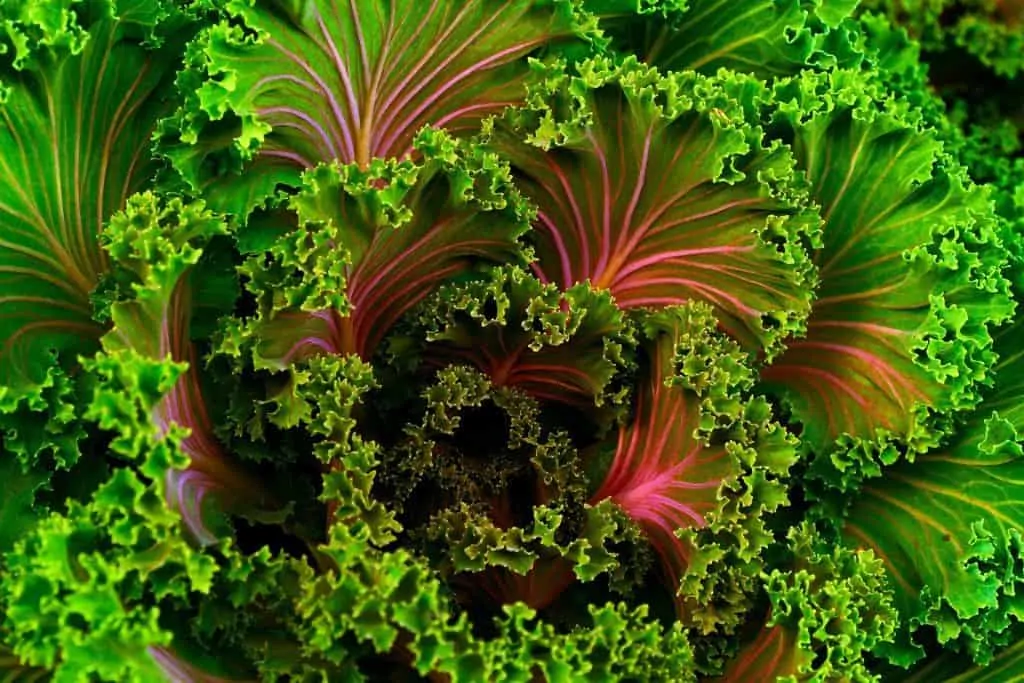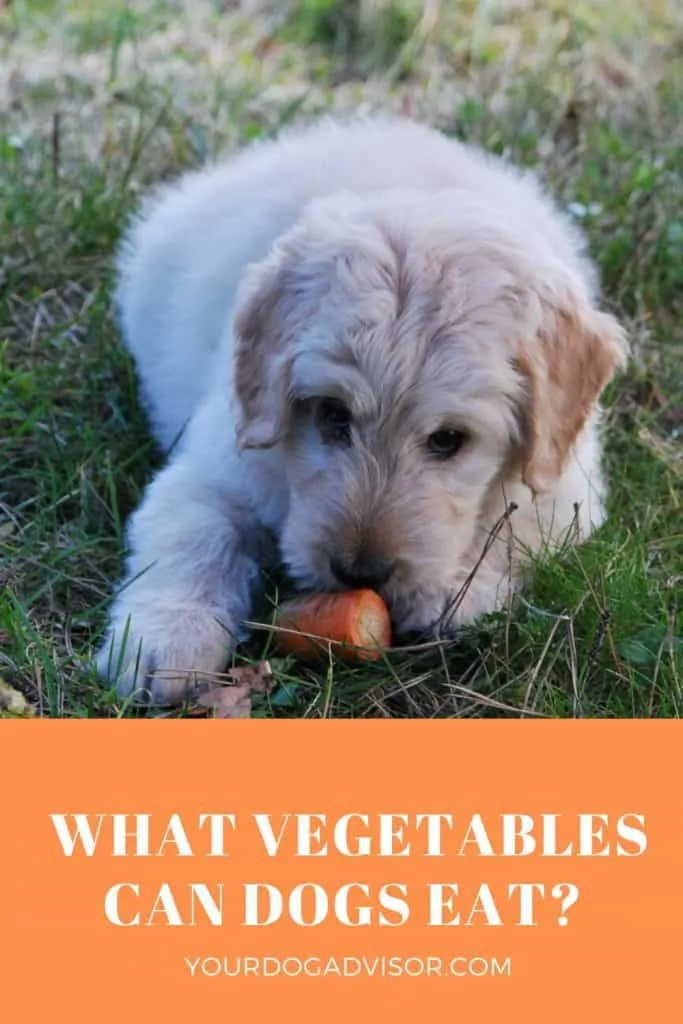Eat your vegetables! It’s an admonition almost everyone recalls hearing from their mom at the dinner table when they were a kid. Even as adults, we are inundated with advice from health and nutrition experts telling us to eat at least five servings of fruits and vegetables every day. Vegetables are brimming with phytonutrients, substances found in certain plants that promote good health and, in some cases, help fight disease. So it’s definitely a smart idea to follow the expert’s advice.
Vegetables can be a safe, tasty, low calories treat for your dog.
But while virtually all vegetables are beneficial for humans, the same can’t be said about your dog. In fact, while dogs can eat many vegetables and will benefit from many of them, some vegetables are actually toxic to dogs and cats. Others are fine when fed in moderation, but can cause problems if your dog eats too much.
That being said, dogs can thrive on a vegetarian diet, says Dr. Jenifer Coates, DVM. But you must be careful to give her the right balance of nutrients to maintain optimal health. Protein, in particular, tends to be scarce in plant-based diets. So make sure you include high-protein vegetables such as lima beans, peas and spinach as well as soy products, such as edamame, soybean sprouts and tofu. If you want to feed your dog a lacto-ovo-vegetarian diet, you can also give her eggs and low-fat cottage cheese.
So what vegetables can dogs eat? And how much is too much of a good thing? Here’s a rundown of what’s good for your dog and what to avoid.
Contents
Asparagus
Asparagus is a highly nutritious vegetable that’s loaded with antioxidants such as vitamin C, vitamin E and glutathione, The green, white or purple stalks also contain a variety of flavonoids, a large group of plant compounds that have been shown to combat oxidative stress and, at least in humans, promote brain health. They are also very low in calories (20 calories per ½ cup cooked) so they are a great low-cal snack if your dog is overweight.
But is asparagus as good for dogs as it is for humans? To some extent, yes. It’s not toxic, and its antioxidant and vitamin profile make asparagus a healthy snack. But the spears are very tough and difficult to chew when raw, so it’s a good idea to steam them lightly before feeding them to your dog so she doesn’t choke.
Asparagus can be a healthy, low calorie treat for your dog, but make sure you chop in into small pieces and cook it first. Steaming and roasting are two easy ways to prepare asparagus for your pet.
Asparagus also contains a generous amount of fiber, which can be a double-edged sword when you feed it to your dog. On one hand, fiber is filling, so it satisfies your dog’s hunger without adding a lot of calories. But on the other hand, fiber can cause bloating, gas, and diarrhea if your dog eats too much. So it’s a good idea to start very slow and see how your dog reacts.
Another fact you might want to consider before feeding your dog asparagus is that dogs, like humans, can have “asparagus pee.” Caused by the breakdown of the chemical asparagusic acid in the gastrointestinal tract, this foul smelling urine is the result of sulfur that’s released as the asparagusic acid breaks down. It’s not at all harmful, but if you’re not expecting it, it may come as a shock.
Broccoli
Broccoli is a great vegetable. It’s low in calories (about 30 calories per cup), high in fiber, and contains generous amounts of vitamins and minerals, including vitamins C and K, potassium, iron and manganese. It also contains two important compounds that have been shown to fight cancer in humans and lab animals, sulforaphane and Indole-3-carbinol. And while it’s not been established that these compounds fight cancer in dogs, there’s no reason to believe they don’t provide the same benefits to canines as they do for other species.
Still, feeding your dog broccoli isn’t always a wise idea. For one thing, the stalks are extremely tough, so you need to be very careful about feeding them to your dog uncooked. If you do, cut them up into bite-size chunks and stay with your dog while she eats them to make sure she doesn’t choke. Better yet, steam or boil them until they are soft enough for her to chew.
And don’t feed your dog broccoli crowns. They contain compounds known as Isothiocyanates, which are powerful antioxidants but can cause mild to severe gastrointestinal irritation in some dogs.
Brussels Sprouts
Part of the same family of cruciferous vegetables as broccoli, kale, cabbage and cauliflower, Brussels sprouts are another healthy, low-calorie treat for your dog. Like broccoli, they contain lots of Vitamin C and K, and they are loaded with the glucosinolate, a sulfur-containing compound that breaks down in the body into the cancer-fighting phytochemical Indole-3-carbinol. In some human studies, glucosinolate-containing vegetables have also been shown to have a mildly protective effect against heart disease.
Despite their bad reputation with many humans, sauteed Brussels sprouts can be a great treat for your dog. Just remember not to feed her too many at one time.
Often cited by humans as their No. 1 most-hated vegetable, raw Brussels sprouts have a somewhat bitter taste. But when properly prepared, they can be nutty and delicious and make a wonderful homemade treat for your dog. I saute mine in a little olive oil (add salt and seasonings later if you’re sharing with your dog) until they are just tender, and cut them up into small pieces to feed to my dog as a treat. Just remember, a little goes a long way! Like all cruciferous vegetables, Brussels sprouts are high in fiber and can easily give your dog some pretty stinky gas.
Carrots
Sweet and delicious whether served raw or cooked, carrots are a great treat for your dog. When served raw, they act like dental chews to help clean the tartar from your dog’s teeth (or keep it from developing in the first place). And because they taste good and have very few calories (about 4 calories for a baby carrot; 40 calories for two large ones), you can feed them to your dog every day. Carrots are also a great source of beta carotene, an antioxidant that is converted in the body to vitamin A, which is very important to skin and eye health and helps support the immune system.
With that said, it’s important to keep in mind that carrots contain cellulose, which dogs can’t digest. So your pooch will miss out on carrots’ many nutritional benefits if you only feed them raw. So even if you give them to your dog mainly for dental health, give her some lightly steamed carrots once in a while as well. You might even try mashing them and adding them to her kibble as a special mealtime treat.
Eating raw carrots is a wonderful way to get your dog’s teeth clean and keep tartar buildup down.
Celery
A staple in the diet of every person who is trying to lose weight, celery makes a tasty, filling, low-calorie snack. With just 10 calories per stalk, celery is made up mostly of water, so it doesn’t provide a lot of nutrients. But it does contain an impressive array of phytochemicals, including many flavonoids, antioxidants and anti-inflammatory compounds. Unlike some vegetables, celery has also been shown to retain much of its nutritional value when it’s cooked.
Still, giving your dog celery isn’t always a good idea, especially if she’s on the small side. That’s because celery’s chewy, stringy nature makes it hard to chew, and it may get stuck in your dog’s throat. In very small dogs, such as chihuahuas and Yorkies, it can even become lodged in the gastrointestinal tract causing partial or complete bowel obstruction, which can be extremely serious. The best way to avoid these pitfalls is to feed your dog steamed or sauteed celery, or skip it altogether in favor of another healthy veggie treat.
Corn
Corn is both a whole grain and a vegetable, albeit a “starchy” one. Sweet and delicious, it’s also a popular dietary staple in many parts of the world, including the U.S. It’s also used in many dog foods as both an inexpensive filler and a source of protein, fiber, carbohydrates and vitamins.
Corn is a tasty treat for your dog, but remember to never allow her to eat the cob. It’s not digestible and can make her very sick.
Source: “Lucy Eats Corn” by Philip Bump licensed under CC SA 2.0
But is corn a good vegetable to feed your dog? According to the American Kennel Club, giving your dog a little corn once in a while is fine. Just make sure you remove it from the cob first. Dogs cannot safely eat corn cobs; they can’t digest them and they can become lodged in the intestines causing a bowel obstruction, which can lead to death. Because It’s quite high in calories (177 calories per cup), corn also isn’t the best vegetable to give to an overweight dog. You can, however, give him air-popped popcorn ( with no butter or salt), which contains just 31 calories per cup.
Green Beans
Green beans are a great source of vitamins, minerals and other nutrients, including vitamins A, C and K, thiamine, riboflavin, folic acid and more. They also contain small amounts of Omega-3 and Omega 6 fatty acids, which are important to the health of nearly every part of your dog’s body, including his heart, liver, reproductive organs, joints and skin.
That said, green beans aren’t just nutritional powerhouses. They are also very low in calories, tasty and easy to digest when cooked. One word of caution, however: Like all legumes, green beans contain a kind of protein called lectin, which can cause gastrointestinal upset, nausea and vomiting when eaten in large amounts. Cooking quickly destroys these proteins, however. So if your dog has a sensitive stomach, feed him cooked fresh green beans or canned, unsalted green beans instead of raw.
Kale
Kale is a so-called superfood that has gained enormous popularity in recent years. In addition to containing large amounts of vitamin A, C and K and a host of minerals, it is loaded with antioxidants that have been shown to promote heart health and even lower cancer risk. It is also very low in calories: one cup of raw kale contains just 33 calories and virtually no fat.
Kale is one of the most nutrient-dense vegetables on the planet, but it contains a compound that can be harmful to dogs.
But as healthy and nutritious as kale is for humans, it is not a good vegetable to feed your dog. The reason: According to Mara Ratnofsky, DVM of Angell Animal Medical Center in Boston, kale contains high amounts of calcium oxalate, which can cause kidney and bladder stones in dogs.
Lima Beans
Like all legumes, lima beans are high in protein, low in fat, and contain beneficial minerals like iron, magnesium and potassium.They’re also high in fiber, which can help your dog feel full — a nice benefit if your dog is overweight.
With that said, there has been some controversy in recent years about a possible connection between legumes in commercial dog foods and a heart condition known as dilated cardiomyopathy (DCM). The connection has not been established definitively. In fact, as recently as 2019 the U.S. Food and Drug Administration issued a statement that it has not determined that legumes are in any way responsible for diet-related DCM. Therefore, lima beans are still considered safe for dogs.
Mushrooms
Technically, mushrooms are not vegetables: They are the fruiting bodies of fungi, which, misconceptions aside, are not even plants. Yet, here in North America and in many places across the globe, they are a dietary staple — used in everything from pasta to risotto to omelets to soups. People love them! And so it’s natural that we want to know if we can feed them to our dogs.
The answer to that question is somewhat equivocal. As a rule, the white mushrooms you buy at a grocery store (which may be sold as button, white, crimini or portabella mushrooms)
are perfectly safe for dogs. They are also incredibly low in calories (about 20 calories per cup) and a good source of protein and vitamin D. Wild mushrooms, on the other hand (or mushrooms sold by a vendor you don’t know) are definitely not safe or either you or your pup. That’s because, according to mushroom expert David Fischer, about half of the 250 or so species of mushrooms found in North America are toxic and half are edible. But only a very well-versed expert can be sure about which is which.
So if you’re having a mushroom frittata made from mushrooms you bought at the store, go ahead and share it with your dog if you want. But don’t allow your dog to eat wild mushrooms he finds on his walks, and don’t feed him mushrooms from a questionable source. Mushroom poisoning can have devastating consequences, including death.
Onions
Onions of any kind in any form are a definite no-no for dogs. They contain two types of compounds — disulfites and thiosulphates — which can destroy the dog’s red blood cells (a condition known as hemolytic anemia). Nor does your dog need to ingest very much to develop this condition. According to Nationwide Pet Insurance, as little as 15 grams per kilogram (½ to 1 ounce per 2.2 pounds) can cause serious, even life-threatening harm. Japanese dog breeds (akita, Japanese chin, and shiba-inu, for example) may be harmed by an even lower dose.
Onions are so toxic, in fact, that you need to be careful about any “people food” you share with your dog. Spaghetti sauce, pizza, and many prepared sauces contain onion, as do many lunch meats (in the form of onion powder.) To be safe, it’s best not to feed any food you didn’t prepare yourself to your pet.
Spinach
Like its cousin, kale, spinach is packed with nutrition, including vitamins A, B, C and K, and lots of iron and antioxidants. It’s also very low in calories and, when properly prepared, tastes great. Nevertheless, spinach is not the best choice of vegetable to feed your dog. According to the American Kennel Club, it contains high amounts of oxalic acid, which, in sufficient quantities, can cause kidney failure in dogs.
A balanced diet is an important part of helping your dog stay healthy and happy. And with a little forethought and preparation, it is quite possible to add vegetables to your dog’s diet with good effect. With that being said, it’s always a good idea to check with your vet before feeding any new food to your dog, especially if she has any underlying condition such as liver or kidney disease. What’s healthy and nutritious for one dog may be contraindicated for another, so always be safe and ask for advice.

Jen Jones is a professional dog trainer and behavior specialist with more than 25 years of experience. As the founder of ‘Your Dog Advisor’ and the ‘Canine Connection’ rehabilitation center, she applies a holistic, empathetic approach, aiming to address root causes rather than merely treating symptoms.
Well known for her intuitive and compassionate approach, Jen adopts scientifically-proven, reward-based methods, encouraging positive reinforcement over punishment. Jen specializes in obedience training, behavior modification, and puppy socialization. Her innovative methods, particularly in addressing anxiety and aggression issues, have been widely recognized. Jen has worked with many of the world’s leading dog behaviorists and in her free time volunteers with local animal shelters and rescue groups.
